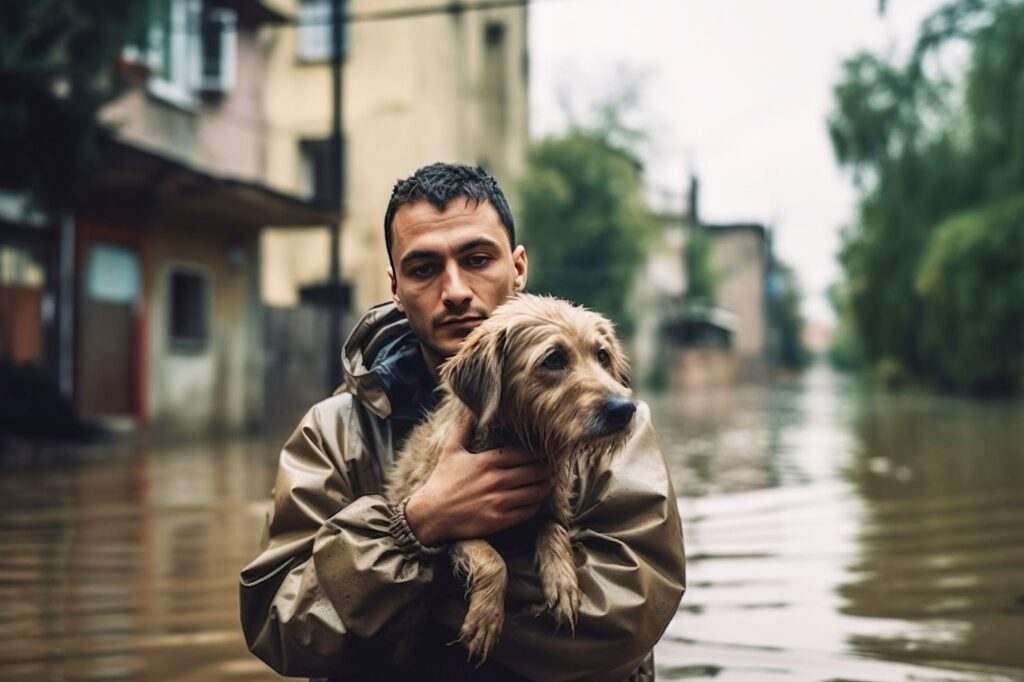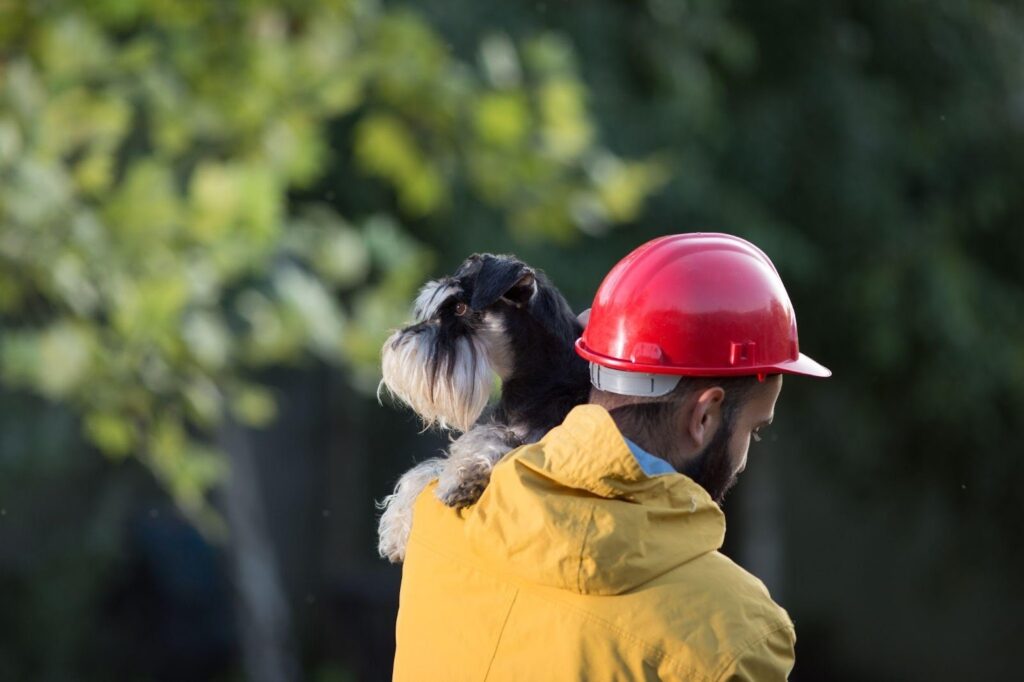When disaster strikes, the safety of every family member, including pets, becomes critical and depends on disaster preparedness. Pets often get overlooked in emergency plans, yet they require specific care that, if ignored, could lead to severe distress for both the pet and owner.
Understanding the risks and preparing accordingly is vital to ensuring the safety and well-being of your pets and helping prevent potential distress during such unpredictable events. We will guide you through integrating your pets into your disaster preparedness strategy to ensure they are safe and not forgotten.
Risks to pets during disasters
Various disasters pose unique threats that vary significantly by geographic location. For example, hurricanes and floods lead to sudden evacuations, risking pets becoming lost or left behind. These events may also expose pets to contaminated water, posing serious health risks.
Earthquakes frighten pets, leading to injuries or escape attempts, disrupting their routines, and causing stress.
Wildfires require rapid evacuations and are often traumatic, especially since pets are prone to smoke inhalation due to their proximity to the ground.
Geographic considerations are also vital:
- In hurricane-prone areas, ensure a pet-friendly evacuation plan is in place, including knowledge of local shelters that accept pets.
- In earthquake zones, secure pet enclosures and maintain a ready-to-go pet emergency kit.
- In regions vulnerable to wildfires, have multiple evacuation routes planned and prepare pets for quick travel.
By understanding these risks and tailoring your emergency preparedness to your location, you are able to protect your pets effectively. This preparation safeguards their well-being but also secures your peace of mind during stressful times.

Creating a pet emergency kit
Creating a comprehensive pet emergency kit is essential for disaster preparedness. Here’s how to ensure your pets have everything they need for their well-being during emergencies:
- Food and water: Stock a week’s supply of your pet’s regular food and fresh water in airtight, waterproof containers. Include collapsible feeding bowls to conserve space and enhance portability.
- Medications and medical records: Store necessary medications and a copy of your pet’s medical records, including vaccination records, in a waterproof container. Be sure to include feeding routines and special care instructions.
- Leashes, harnesses, and carriers: Keep sturdy leashes and harnesses ready for dogs, and secure carriers for cats and other pets. Ensure carriers are comfortable, allowing pets to stand and turn around, to maintain control and safety during an evacuation.
- Comfort items: Pack favorite toys, bedding, or treats to soothe and comfort your pet, helping them stay calm in unfamiliar settings.
Select and organize these essentials in a dedicated pet emergency kit, and regularly update the kit to keep supplies fresh and ready for use. This preparation ensures you quickly respond to any emergency with everything your pet needs.
Securing a safe space
Securing a safe space for your pets during a disaster is essential, whether you choose to shelter at home or need to evacuate. Here’s how to ensure your pets’ safety effectively:
At home
Choose a room that is easy to clean and free of hazards like loose wires or toxic substances. The area should be away from windows to protect against broken glass or debris during storms.
Secure the space to prevent pets from escaping or hiding in inaccessible spots. Remove potential hazards that could fall or cause injury and keep harmful substances out of reach.
Place your pet’s bed, blankets, and favorite toys in the area to make them feel secure. Ensure easy access to food and water, and plan to handle your pet’s bathroom needs indoors safely.
Finding pet-friendly accommodations
Consult local emergency management agency websites or contact them to identify pet-friendly emergency shelters or accommodations. Not all shelters accommodate pets, making prior knowledge crucial.
Investigate pet-friendly hotels or motels along your evacuation route and compile a list for quick reference.
Arrange with someone outside your immediate area to care for your pets if necessary, ensuring a welcoming place in case of a sudden evacuation.
Health and safety precautions
Maintaining the health and safety of your pets during emergencies is crucial. Here’s a guide to ensure their well-being and manage their stress:
Health maintenance
Ensure your pets’ vaccinations are up to date to guard against diseases common post-disaster, like leptospirosis. Always have vaccination proof ready for boarding or sheltering needs. Keep a waterproof container in your emergency kit with copies of your pets’ medical and vaccination records for easy access and protection.
Stress management
Pack comforting items such as favorite toys, blankets, or beds in your emergency kit to alleviate your pets’ anxiety. Maintain calmness around your pets, as they can detect stress; this helps keep them calm. Regularly practice evacuations and travel routines to reduce their panic during actual emergencies.
Emergency care
Prepare a first aid kit tailored for your pets, including gauze, tape, scissors, tweezers, antiseptic wipes, and a pet-specific first aid manual. Understand how to manage common pet injuries like cuts, burns, or heatstroke, learn CPR techniques, and check vital signs.
Compile a list of local veterinarians and 24-hour animal hospitals, and keep the animal poison control hotline handy for emergencies.
Staying proactive with these steps enhances your pets’ safety and ensures you are prepared to address their health needs during any emergency. Regular updates to your plans and kits are essential for readiness.

Training and behavior
Teach your pets basic commands like “come,” “stay,” “sit,” and “leave it.” Mastery of these commands can be crucial in emergencies, allowing you to manage your pets quickly and effectively. Gradually expose your pets to travel sounds and sensations, like being in a vehicle or crate. This desensitization can significantly reduce their stress in real evacuations.
Regularly expose your pets to various environments, noises, and people to enhance their adaptability and reduce anxiety in new or chaotic situations. Train them for specific emergency scenarios, such as wearing a muzzle or interacting with strangers, to ensure they can handle potentially overwhelming situations without panic.
If your pet exhibits anxiety or aggression that may impede emergency response, engaging a professional trainer can be beneficial. They can provide specialized techniques and training strategies tailored to your pet’s needs, ensuring they are well-prepared for any crisis.
Identification and documentation
Ensuring your pets can be properly identified and their important documents are secure is crucial in emergencies.
Microchipping and tags as essential tools for pet identification.
- Microchipping: Implant a microchip in your pet. This tiny device, injected under the skin, stores a unique ID that a scanner at most veterinary clinics and animal shelters can read. Microchipping increases the chances of being reunited with your pet if they get lost during a disaster.
- Tags: Equip your pet with a collar and ID tags that include your name, phone number, and any urgent medical needs. Tags offer an immediate form of identification and can facilitate a quick return.
Keep all critical documents — such as registration, adoption papers, vaccination records, and medical histories — in a waterproof container. This step protects the documents from water damage and ensures they are readily available when needed.
Create digital backups of your pet’s documents. Store these copies in a secure cloud service or on a USB drive that you can access easily. Digital copies are especially useful if physical documents are lost or destroyed.
Maintain a list of important contacts related to your pet’s care, including your vet, local animal shelters, and pet-friendly accommodations. This list should be kept with your pet’s documents to ensure all information is together and easy to access during an emergency.
By implementing these identification and documentation strategies, you provide your pet with an extra layer of security and ensure that essential information is at your fingertips when disaster strikes.
Communication and help
Effective communication strategies and community support are vital when preparing for emergencies, especially concerning pet safety and recovery. Here’s how to organize support and use technology to your advantage in crisis situations.
Establishing a buddy system with neighbors for pet care during emergencies
Set up a buddy system with trusted neighbors who can check on and care for each other’s pets if one household cannot return home immediately following a disaster. This mutual aid ensures that pets are not left alone for extended periods during emergencies.
Exchange key information about your pets, such as their feeding routines, medical needs, and behavioral tendencies, with your designated buddy. This preparation allows for smoother, more effective care under stress.
Using social media and pet recovery databases to report or search for lost pets
Leverage the power of social media platforms like Facebook, Twitter, and neighborhood forums like Nextdoor to post lost and found notices. These platforms can rapidly spread the word and be instrumental in recovering lost pets.
Register your pet in national and local pet recovery databases. If your pet is lost and then found, these databases can help match your pet’s microchip or tag information with your contact details, facilitating a quick reunion.
These steps help manage the immediate aftermath of a disaster and improve the chances of a happy resolution should your pet become lost.

Long-term considerations
When planning for emergencies, it’s crucial to think about the long-term needs of your pets, especially in situations where displacement might extend over a period of time. Here’s how to prepare for potential long-term scenarios and manage the financial aspects related to your pets’ care during emergencies.
Pet-friendly housing options
Research and list pet-friendly accommodations, such as hotels, motels, and shelters that accept pets during evacuations. Keep this list accessible in your emergency kit.
Extended stay preparations
For prolonged displacement, consider the necessities for a more extended stay in temporary housing. This includes ample pet supplies, portable enclosures like crates or carriers, and items to maintain the comfort and routine of your pets.
Financial considerations and insurance for pets
Establish an emergency fund specifically for your pet’s needs, which can cover unexpected expenses like veterinary care, boarding, or additional supplies during a crisis.
Invest in pet insurance that covers emergency vet visits and procedures. This can alleviate the financial burden of unexpected medical expenses resulting from injuries or illnesses related to disasters.
Keep a record of all expenses and maintain receipts related to your pet’s care during emergencies. This documentation is essential for insurance claims and possible reimbursement opportunities.
This proactive planning helps mitigate stress and financial strain, allowing you to focus on rebuilding and returning to normalcy with your pets by your side.
Be prepared and partner with Utah Disaster Clean Up
When disaster strikes, the damage is often overwhelming, extending beyond immediate pet care needs to encompass broader property restoration.
Utah Disaster Clean Up specializes in addressing the aftermath of any disaster. Our expertise ensures that your home and, by extension, the safe haven you provide for your pets is restored efficiently and compassionately.
Whether dealing with fire, flood, or any other unforeseen damage, we stand ready to help you recover your space quickly, minimizing the impact on your family and pets.
So, as you take the steps to prepare your pets for emergencies, remember that you’re not alone. With Utah Disaster Clean Up, you have a reliable ally ready to assist with every aspect of disaster recovery, ensuring that your home and your pets are cared for in the best possible way. Call 435-512-1584 24/7 or contact Utah Disaster Clean Up to learn more.



